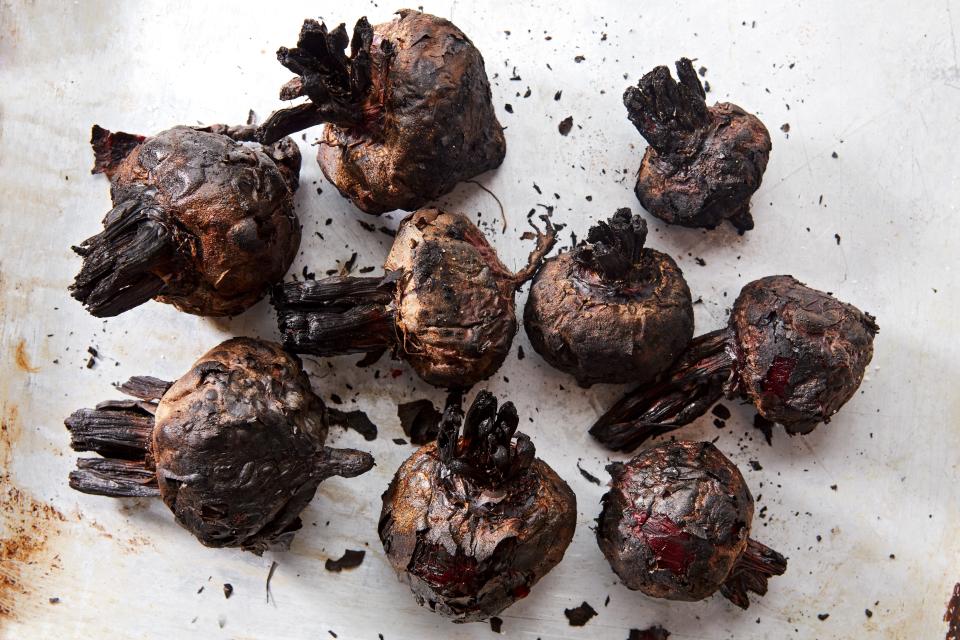How to Grill Whole Vegetables and Make Summer Even More Effortless
Pull vegetable out of grocery tote; place directly onto hot grill. Doesn't that sound nice? It is nice (and fun! and easy! and impressive!) to grill a whole vegetable, and then to turn that whole grilled vegetable into a meal. My favorite part about knowing how to grill whole vegetables is that there's next to nothing I need to do to those vegetables before I start cooking them.
I've been throwing a lot of whole vegetables onto the grill this summer, and I'm not done yet. I've made many versions of whole grilled bell peppers—the skin turns black and is easy to peel off, and the flesh inside turns super-silky and smoky. But I also fell in love with coal-roasting whole beets, grilling a whole eggplant until it turns to delightful mush, and grilling a whole head of cauliflower while basting it with a spicy BBQ-ish sauce for a show-stopping centerpiece to a vegetarian dinner. I'm still working on some of my techniques, but summer isn't over yet. So far, this is what I've mastered—and so I figured it's time to share it with you while it's still grilling season!

Grilled Whole Beets - INSET
Use Still-Smoldering Coals to Meal-Prep Whole Vegetables
After cooking a grilled steak dinner for friends on the big charcoal grill at my lake house the other weekend, I pulled off the grate and nestled a bunch of whole, un-trimmed and un-scrubbed beets into the still-glowing coals. As we lingered on the deck with wine, I got up and turned the beets a few times. Eventually I dug them out completely and tucked them, blackened and sooty, in a bowl in the fridge before I went to bed. (Another glass of wine and I would have completely forgot them.)
The next day, I stained my hands red while pulling the charred skins off, then sliced the soft and rosy roasted beets into wedges. They were pleasantly smoky and deeply flavorful—especially after I tossed them in olive oil and vinegar and piled them on a plate with burrata mozz, crushed Castelvetrano olives, and cherries. With lots of bread (and maybe more wine) for lunch, those beets were divine.
Sure, that salad would be great with oven-roasted beets too, but the smoky char aroma infused into the beets is something special, and I didn't have to heat up the oven, either. Plus, the act of repurposing my dinner coals to prepare for tomorrow's lunch felt pretty clever. And the act of burying whole dirty beets into smoldering coals had a bit of romance to it, too.
Grilled Beet Salad with Burrata and Cherries
Any tough-skinned vegetable, like sweet potatoes or regular potatoes, is a good contender for a slow roast in dying coals. But my favorite way to deploy the technique is with whole eggplants (more on that below). If you don't have a charcoal grill, don't despair: you can achieve a similar slow-smolder effect on a gas grill by cooking whole tough-skinned vegetables on the grates over low indirect heat—just keep the lid down to help trap some smoke and heat in there.

Grilled Eggplant with Harissa Viniagrette - RECIPE
Photo by Joseph De Leo, Food Styling by Anna StockwellMake coal-roasted whole eggplant even tastier
Using the whole-vegetable grilling method for eggplant is a very good idea—the flesh collapses into luscious smokiness, ready to be whipped into eggplant salad, layered into sandwiches, or dressed with a harissa-honey vinaigrette and served whole.
But there's the one not-so-great thing about grilling an eggplant whole: There's nowhere for all the moisture to escape—a lot of it is still trapped inside. So I use a trick I learned from this recipe by the Canal House ladies and let my whole grilled eggplant drain (after peeling) on a wire cooling rack set into a rimmed baking sheet while it cools. With that extra moisture dispelled, the eggplant is ready to be drenched in a sweet, tart, and just-spicy-enough harissa-honey vinaigrette. To help the dressing infuse into the eggplant, be sure to make slits lengthwise along the grilled eggplant before coating it in dressing—it's a trick that makes it even tastier. Spoon onto grilled bread for an appetizer for a small crowd, or split it with your partner for dinner.
Grilled Whole Eggplant with Harissa Vinaigrette
Baste Porous Whole Vegetables as You Grill
Not all whole vegetables should be nestled into hot coals. Anything with a textured, tender surface that you want to eat, like corn on the cob or cauliflower, is best cooked whole up on the grates of your grill. Because a whole cauliflower has so many nooks and crannies, I learned to baste it with sauce as it grills. The sauce seeps down between all the little florets to infuse the whole thing with flavor. I was thinking about Buffalo wings when I came up with my basting sauce, but wanted it to be a little bit more savory and umami forward, so I melted some butter with Frank's hot sauce, soy sauce, and some ketchup. Sounds like a weird combo, but it works, and gives the cauliflower excellent color, too. Keep the pot of sauce on the grill to keep it melted and brush-able as you cook the cauliflower.
Cauliflower was the only whole vegetable that needed a bit of prep before grilling: I had to get the center a little bit softer, so I steamed it in the microwave just a bit first. Without that step, it was just too crunchy inside, and I wanted to be able to enjoy the whole thing, stem and all, fresh off the grill with my miso mayo. Come to think of it, that miso mayo would work with pretty much any vegetable you threw on the grill—or in nestled in the coals, for that matter.
Grilled Whole Cauliflower with Miso Mayo
Originally Appeared on Epicurious



